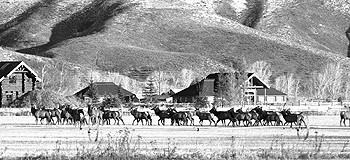| local
weather |
| front page |
| classifieds |
| calendar |
| public meetings |
| recreation |
| subscriptions |
| express jobs |
| about us |
| advertising info |
| classifieds info |
| internet info |
| sun valley central |
| sun valley guide |
| real estate guide |
| homefinder |
| sv catalogs |
| hemingway |
| Produced
& Maintained by Idaho Mountain Express, Box 1013,
Ketchum, ID 83340-1013 208.726.8060 Voice 208.726.2329 Fax |
|
Copyright © 2003 Express Publishing Inc. All Rights reserved. Reproduction in whole or in part in any form or medium without express written permission of Express Publishing Inc. is prohibited. |
Friday — April 30, 2004
![]()
Planners looking at the future of the Bellevue Triangle—forecasted as the new growth hot spot in Blaine County—will have to deal with several issues confronting the county as whole, including wildlife, open vistas, housing development and agriculture. Express photo by Willy Cook
Planners contemplate com plan revisions
P&Z looks south as county growth ‘pressure’ mounts
By PAT MURPHY
Express Staff WriterJohn Babsone Lane Soule’s 1851 advice to "Go west, young man" to find a future has something of a modern parallel in Blaine County.
The Planning and Zoning Commission is looking south where much of the county’s potential future probably lies.
Four P&Z commissioners attending a work session Tuesday night to discuss the county’s Comprehensive Plan agreed that the so-called Bellevue Triangle area—south of the city of Bellevue bounded by Highway 75 on the west, Gannett Road on the east and U.S. 20 on the south—is the new growth hot spot in Blaine County.
Land is less costly there, farm tracts could be chopped into residential home sites and the ambiance of open spaces provides a more rural setting.
That was only one of several issues dwelled on during two and half hours by chairman Don Nurge and commissioners Doug Werth, Lawrence Schoen and Chip Bailey. All said they believe the comp plan needs revisions or updating to deal with Blaine County’s rapid changes since 1994 revisions.
As defined in official literature, the comprehensive plan, which covers scores of topics related to government management of land use and development, is "to be used as a general guide for the orderly development of Blaine County."
The work session was called to answer five questions: does the comp plan still represent the direction the county wants to go; do P&Z commissioners trip over plan provisions that need to be changed; does the plan prevent desirable outcomes; do changes in the county require changes in the plan, and what physical and political changes in Blaine County affect the plan for the future?
Commissioner Werth said it would be hopeless, however, for the P&Z to even consider making changes in the plans until the board has fresh, updated information on population changes, trends in where the county is developing and an inventory of public services.
That touched a nerve with Blaine County Commissioner Sarah Michael, who attended the session as an observer.
The comp plan, she said, doesn’t deal at all with alternative transportation modes, does not include provisions for cluster housing to help preserve agriculture, neglects serious attention to enforcement of water conservation, does not deal with the issue of chemical and pesticide uses and is silent on sensible energy uses.
Nurge also pointed out that the comp plan does not include "dark sky" provisions that regulate outside lightning to prevent light pollution of nigh skies, although Wood River Valley cities have adopted individual ordinances.
Schoen said that as Blaine County’s growth continues, more intense conflicts are developing between residential development and natural resources.
As an example of the differing perspectives among residents, Commissioner Bailey said the term "rural" nature in the comp plan has conflicting meanings.
"Anyone who lived for 40 years in Manhattan would think Main Street (in Hailey) is rural, but someone living on a farm would think that’s urban," Bailey said.
County Commissioner Michael chimed in again, and wondered whether the 80,000-population once predicted for Blaine County "is where people want to go."
"Do we want open spaces open? Do we want a new town" to accommodate a larger population, Michael asked.
Commissioner Bailey was prompted to ask whether the plan has fulfilled the feelings and goals of citizens in 1994, the year of the last major version of the plan?
P&Z planner Deborah Vignes suggested that any changes to the comp plan, and subsequent ordinances adopted by the county commission, would require "political will to make changes."
Not the least change, she noted, would be requiring affordable or community housing in new subdivisions as a condition of approval.
Schoen said that ultimately the public needs to be deeply involved in deciding what changes are required in county ordinances that shape growth.
But commissioner Werth hinted that whatever revisions and changes are made to the plan, the board might need to consider hiring an outside consultant to help.
The four agreed that several key issues--agriculture, land use, natural resources and housing--should be targeted for special study at a future meeting.
Commissioners Judy Harrison, Jerry Allred and Suzanne Orb were absent.
The sole citizen attending the meeting, John Miley, of Hailey, told the commissioners that not much future planning can be undertaken until the Friedman Memorial Airport Authority decides whether to build a new airport and where, and what it will do with the Hailey airfield, which has more than 200 acres situated virtually in the path of southward growth trends.

The Idaho Mountain Express is distributed free to residents and guests throughout the Sun Valley, Idaho resort area community. Subscribers to the Idaho Mountain Express will read these stories and others in this week's issue.
















